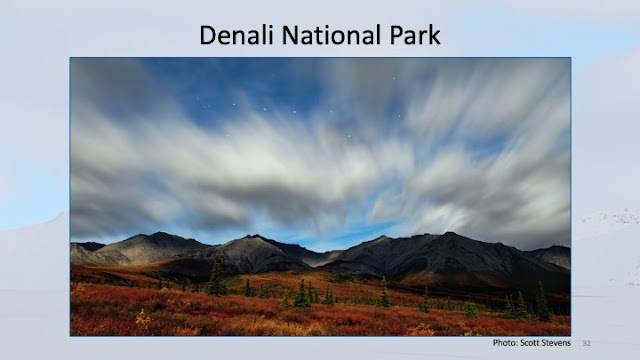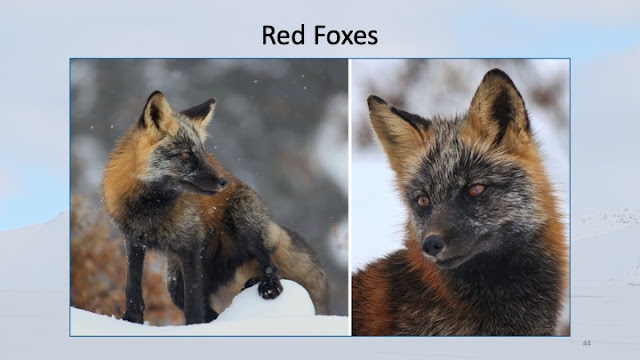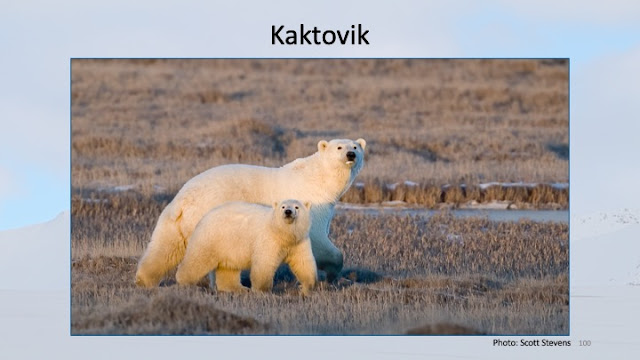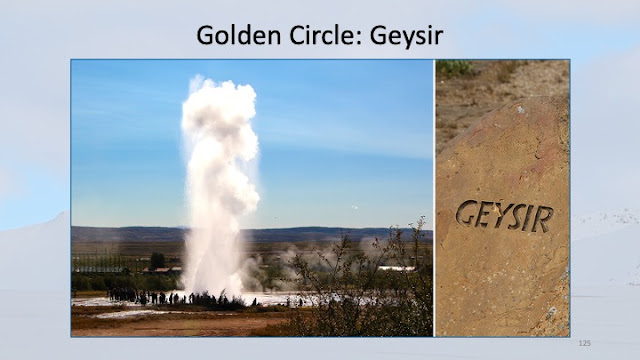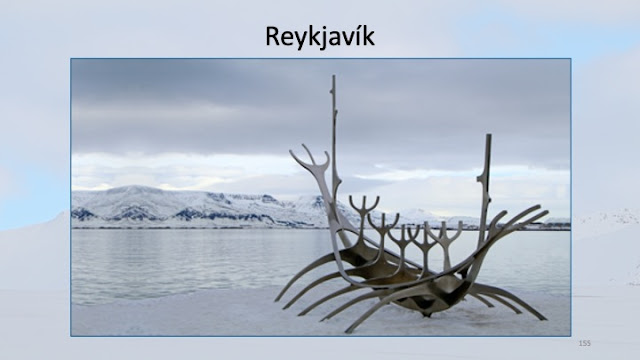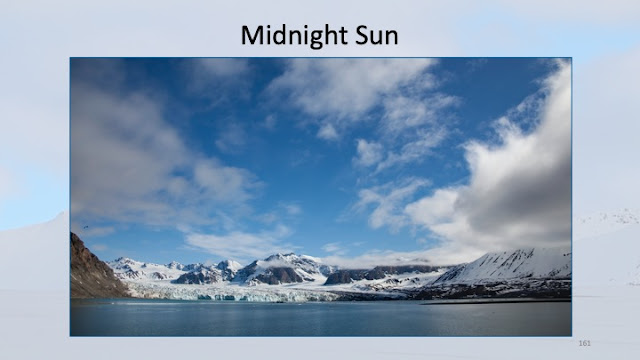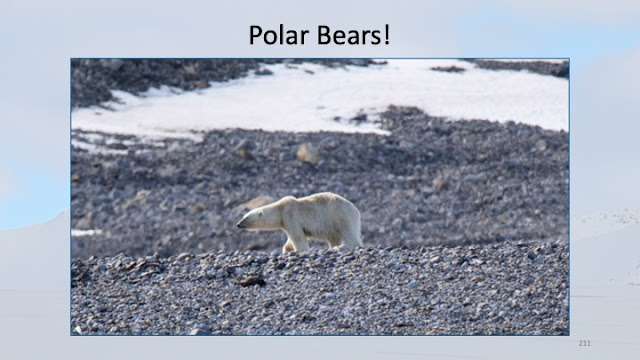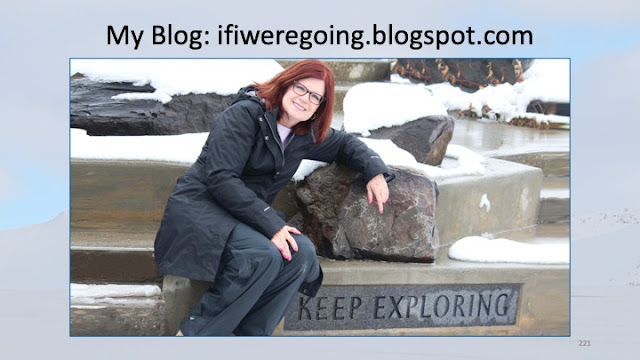I am married to a photographer and I have a degree in communications, so photography has been a part of my entire adult life. I have been shooting seriously for about 10 years, especially since I retired in 2013. I shoot Canon and my husband shoots Nikon. I have a Mark II 5D full frame with a 28-300mm that I use for landscapes and an 80D with a Tamron 150-600mm that I use for wildlife. I also have a 2.8 20mm that I use with the 5D for night sky.
This presentation includes both my and my husband’s work. At the end, I also provide a list of tour operators and accommodations,
My husband and I prefer nature travel, with emphasis on wildlife. Our favorite places are the Arctic and Subarctic and that is what I am going to address.
Before I start, let me give you my first piece of photography advice. This is something I learned at a National Geographic travel photography workshop. Get ready to write this one down. For great travel photography, you must learn to …
Stand in front of something awesome ...
That’s it … Stand in front of something awesome. So, let’s do that. I am going to talk about …
My husband and I have traveled on every interconnected road in Alaska and to many places roads don’t go. One of our best visits was a seven-week driving trip with our teardrop camper to and from our home in Colorado on the Alaska Highway and the Alaska Marine Highway system.
How do you see and photograph Alaska? Cruising is an option about which I have some strong opinions. I find big ship cruises too big, too impersonal and too disconnected from nature.
But, I love small ship cruises. I have been on two in Alaska.
These small ships have anywhere from 85-150 guests aboard and concentrate exclusively on getting close to nature and scenery …
… as well as experiencing native culture.
Small cruises are more pricey than the big ships, but, for a photographer, the trade-off is worth it. You are closer to everything you want to shoot. And, because the ship is small, you can actually make it to the deck and around to the other side before your photo subject disappears.
Here’s an example of the difference between a big and a small ship: We were on our final cruising day and had not yet seen an Orca. When a guest thought he saw some behind us …
… the Captain turned the ship around and went back. After that, I swore I would always take a small ship!
You can also take the much less expensive option of the Alaska Marine Highway System. The ferry. You can take your vehicle or walk on. Some have cabins. Most allow you to pitch a tent or plop down a sleeping bag on the deck.
Most have naturalists on board. They have schedules, so they won’t turn around to see an Orca. But, they take you by some of the most photographable scenery you’ll ever see.
On cruises, you are going to want a variety of lens lengths. A long lens, preferably a telephoto, is great for wildlife. A wide-angle is good for scenery. If you can get both in one camera, great. I can’t, so I often carry both of my cameras. You can also use your cell phone for quick shots and video.
I generally shoot Program for landscape unless there are tricky lighting conditions and I always shoot Shutter-Speed Priority for wildlife. You can adjust for exposure, but there’s not much you can do if your shot is out of focus.
Capturing wildlife is most definitely hit-or-miss, so take lots and lots of pictures. Don’t waste time checking to see what you got. I have missed some great shots that way. Just shoot. You’ll throw out a lot of empty skies, splashes and bear butts. But, shoot enough and you’ll get some gems. Take lots of cards so you’ll never run out of capacity.
For wildlife, get the eye in focus and it won’t matter if the wings or tail aren’t sharp. If you miss the eye, it’s hard to make anything look good.
Alaska can be cold any time of year and cold diminishes battery performance. So, take lots of batteries and keep your extras somewhere warm. Be prepared to change and recharge them often. When it is below zero, it is not unusual for a battery to appear to die, only to be revived by a quick vacation in your toasty pocket.
Also, be aware that, when it is very cold, your camera might experience extreme condensation as you move from heated to unheated areas and vice versa.
My husband and I often visit Alaska at the beginning or the end of the tourist season, usually in September. That way, we can see animals and the Aurora Borealis.
So, let’s talk about Aurora, also called the Northern Lights. Caused by electrically charged solar particles entering the earth's atmosphere, they are most often seen above the magnetic poles, which, of course, includes Alaska.
The most common auroral color is a pale neon green, but you can also see pink, blue, purple, red, white, yellow or orange. Aurora appears in many forms, including arcs, scattered patches of light, streamers, rippling curtains and shooting rays.
Lots of factors have to line up to see aurora: Dark. Clear skies. And actual solar activity. If the display is strong, however, you can get good results even when the moon is out, at twilight or after dawn or when there is moderate light pollution.
Before pursuing Aurora, check a local weather site for visibility; and go to Spaceweather.com for a forecast that shows where and how intense a display might be.
You will need a fast wide-angle lens, preferably 2.8 or better, plus a tripod, a remote and a headlamp.
Set your lens on manual – it will not work if it is trying to autofocus – and pre-focus it. My husband does that manually by focusing on a distant object before dark; I just set my focus a notch in from infinity. Then, tape the lens with gaffer’s tape to prevent it from getting knocked out of focus while you are shooting.
Set your camera’s screen illumination on low to prevent night blindness and to get a more accurate depiction of exposure.
When Aurora is first starting up, it can be hard to differentiate from clouds with the naked eye. Your camera, however, will register much more of the green. So, shoot the wispy clouds and if they are slightly greenish, something is happening.
In many hotels, you can request an aurora wake-up call. It beats waking yourself up every hour to check the sky.
Now, let’s talk about specific Alaska locations …
One of my favorite places is Denali National Park, which sits between Anchorage and Fairbanks and can be easily reached by car or train.
Technically open year-round, it is broadly accessible only in late May through mid-September. Because it is a fragile environment, you can’t drive your own vehicle past 15 miles of the 90-mile Park road, with a few exceptions I will discuss in a moment.
While there is great stuff in the first 15 miles, especially lots of Moose and Porcupines, you will want to see much more.
So, use the Park’s shuttle bus system which begins limited service in May and full service in early June, weather permitting.
There are several bus options: transit buses where you can get off one and on another as much as you want; tours that feature detailed commentary and that require you to stay with your same group all day; and private transport to the two Denali Lodges at the end of the road.
They have a variety of route lengths. I suggest going all the way to the end and back at least once. If you stay at one of the two lodges, you get the unique opportunity to experience the far end of the road late in the day and early in the morning.
ALL buses – even the transit shuttles – have experienced drivers who provide narration and stop for wildlife. Since the driver is spotting AND driving, the passengers carry a great deal of responsibility for finding wildlife. Photographers are always the best spotters.
There is a Road Lottery you can enter in May that, should you win, permits you to drive your own vehicle the entire road during the second weekend after Labor Day. It is a great opportunity, but sometimes weather keeps the winners from collecting the prize.
Once the lottery weekend is over, all private vehicles may drive up to 30 miles into the park until snow closes the road for the season. We have done this – and it delivered a Canadian Lynx!
A top photo subject is 20,310-foot Denali, the tallest mountain in North America. You may hear that it is obscured by clouds at least 75 percent of the time and you won’t see it. But, climate change seems to be revealing the mountain more often. I have seen it every time I have visited since 2008.
You can ever take an aerial tour. From my experience, I suggest that you make sure the wings on the plane are above the windows. Otherwise, you have to be a contortionist to get your shots.
In Denali, you can expect to see ...
Reservations are a must for lodging or camping. During peak season, it’s a good idea to book the bus in advance because you can’t always get the times you want onsite.
You might even see Beluga Whales in the inlet. They are hard to photograph because they have no dorsal fins, but fun to see, nonetheless.
Kenai Fjords National Park is accessible only by boat. From Seward, you can take a boat tour narrated by a National Park Ranger. I suggest the day-long tour to get the broadest opportunity for scenery and wildlife. And, make reservations in advance. In the Park, you will see …
Generally my trips have been fairly calm, but seas can be rough. If you are prone to seasickness, be prepared. I always wear wristbands and, if it’s looking iffy, I take Dramamine. And, remember, take extra cards and lots of batteries.
The next of Alaska’s eight National Parks, the massive Wrangell – St. Elias, is a bit more off the beaten path. Only a small portion is accessible by road. But, it has an extraordinary photographic gem ...
… the Kennecott Copper Mine stands 14 stories above its namesake glacier and can be reached by foot or a quick van ride provided by the National Park Service.
Glacier Bay National Park is on many Alaskan cruise itineraries. But, you can also get there by ferry or small plane. You can camp or stay at the Glacier Bay Lodge and take a National Park boat tour of the bay. It’s lovely and we have seen great sights there …
But, Glacier Bay often has poor weather. We have twice scrapped air tours and every boat tour I have taken has been foggy until we reached the face of a glacier.
The rest of the National Parks in Alaska are more challenging to visit. Lake Clark and Katmai National Parks, which sit across Cook Inlet from the main part of Alaska, have no roads and must be reached by boat or small plane.
They encompass a wide variety of landscapes, including lakes, coastline, glaciers and active, smoking volcanoes.
Both offer extraordinary opportunities for photographing one of Alaska’s biggest draws: Coastal Brown Bears. A good bet is a lodge devoted primarily to bear viewing. Accompanied by bear guides, you get almost unlimited access to bears.
They are so intent on catching salmon and gorging themselves that they don’t care how close you get.
One place we have stayed, the Farm Lodge in Lake Clark, includes the trip to the lodge on a small plane through the spectacular Lake Clark Pass and, then, daily excursions aboard float and/or tundra planes. These flights deliver incredible scenery and wildlife in some of the most remote places you can imagine.
My favorite Lake Clark adventure started at this beautiful lake, which our pilot/guide informed us – after we landed – that was too short for the plane to lift off fully loaded. So, he flew me to a different location, dropped me off and returned to pick up my husband. The 20-30 minutes I spent alone in the Alaskan wilderness was one of the most incredible experiences of my life.
Katmai National Park is best known for Brooks Camp and Brooks Falls where bears – sometimes dozens – fish during the salmon runs. Two viewing platforms afford great opportunities for bear photos.
You can stay at Brooks Camp, if you can ever get reservations, or you can do what we have done several times and fly in for a day. If you are there during the very busy periods, your time on the viewing platform is limited and it is crowded.
We haven’t been to Brooks Falls at the height of a major salmon run, so we have seen smaller groups of bears. But with less bears, there were fewer people. We had more platform time, sometimes being the only ones there. I think the trade-off was worth it.

All the lodges offer guided fishing, but I prefer to just take pictures or videos …
The two remaining National Parks, Gates of the Arctic and Kobuk Valley, are really difficult to get to because there are no roads, no facilities, no in-park lodging and few tour options. Most visits are fly-in, with the majority of photo opportunities through tiny airplane windows.
It took us two attempts to visit – our first trip was scrapped when my guide failed to show up and the second was marred by bad weather and mechanical problems. I can check these parks off as visited, but the result was primarily the experience and not the photos. That’s a microcosm of Alaska: Weather and Equipment. You have to be ready to roll with it.
Now, let’s talk about Arctic Alaska, specifically the Dalton Highway and the small town of Kaktovik. We have traveled up the 414-mile-long Dalton Highway from Fairbanks to Prudhoe Bay in conjunction with two aurora photo workshops, both held in the fall.
For the Dalton Highway, which is best traveled in winter, you want to go with someone who understands the road and who knows Arctic photography and survival.
Driving up the highway – known as the “Haul” Road because its purpose is hauling equipment to and from oil fields – is a surreal experience. Chock full of natural Arctic beauty, an irony is that the Alaska pipeline and the big trucks plying the highway produce some of the most dramatic photos. But, you may also see ...


Foxes, Arctic Ground Squirrels and Ermine…
In Fall, the days are short, so there is ample time for Aurora, if you have it. It can be cold – as cold as minus 40 degrees – so you have to deal with distortion from heat shimmer, rapidly dying batteries and the possibility of frostbite when you free your fingertips from your mittens to operate your camera.
You need the right clothing and gear: wicking material (not cotton), multiple layers, wind- and rainproof pants, a substantial parka, weather-rated boots, a good hat, warm socks, mittens with glove liners and chemical hand and foot warmers. The scenery and animals are terrific, but maneuvering around in all that clothing can be difficult.
Oh, and there is only one public toilet along the road. Potty stops are quite an experience.
Kaktovik is a small Inupiat town 112 miles east of Prudhoe Bay. An interesting mix of cultures, Kaktovik has a small commercial airfield, but its 300 residents still maintain ancient traditions, including subsistence caribou and whale hunting.
They dump bones that remain after whales are butchered on a spit on the opposite side of the runway from the town. Between late August and early October, this “boneyard” attracts Polar Bears as they wait for sea ice to set up so that they can go hunt seals.
There are numerous guided tours and three “lodges” that offer transportation to the boneyard for viewing. It is one of the easiest and least expensive ways to see Polar Bears.
The accommodations are, shall we say, “rustic,” but not cheap. Generally, you are dependent on the accommodation providers or tour guides for your transportation to the boneyard – sometimes in a van, sometimes an old school bus.
Once, we rented a truck that broke down, stranding us. Walking back to our hotel was definitely NOT an option. Luckily, some locals came by and rescued us. But, it was worth it to see Polar Bears!
If you are really lucky, like we were, you might also get to witness a whale harvest. Generally I am opposed to killing whales, but this is closely monitored native subsistence hunting that is sacred to the people. It was quite an experience.
I can’t cover every part of Alaska, but I will mention two more northern towns worth visiting for both the novelty and the scenery: Nome and Utqiaġvik. Both are reachable only by plane or, infrequently, ship.
Nome, with its gold-mining past, features striking tundra landscapes, old dredges, the rusting “train to nowhere,” lots of birds ...
… and Muskoxen. Muskoxen are common around – and often IN – town. This guy was hanging with his harem by the Nome hospital.
If you go to Nome, book a tour led by the town’s mayor and most colorful resident, Richard Beneville. I don’t have time to share his story, but, trust me, you don’t want to miss meeting him.
Once called Barrow, Utqiaġvik has no trees, a mishmash of old military facilities, gravel roads, abandoned equipment and modern buildings. You can take your picture at the famous whalebone arch and go to the northernmost point in the U.S., Point Barrow.
The beach is strewn with whale and walrus bones that present all kinds of cool photographic opportunities. When a road washout prevented our tour from going to Point Barrow, a local resident drove us there. His truck broke down and we were afraid we would be stranded forever, eaten by a Polar Bear or washed away by a rogue wave. Fortunately, his son had a better truck and got us safely back to town.
You might notice that broken-down vehicles is a theme in Alaska – and I didn’t even talk about the boat we tried to hire in Kaktovik.
The coolest thing about Utqiaġvik is birds, especially he reliable presence of Snowy Owls. We saw about a dozen of them, all relatively close to town.
I could talk all day about Alaska, but I promised you two other spots. Before we leave our 49th state, let me just reiterate a few tips:
- Be prepared to change your plans because of weather, equipment or unreliable providers.
- Take clothing for all types of weather.
- Be prepared to protect your body and your camera from rain and mist. And, don’t use an umbrella. Alaskans just laugh at that.
- Take backup equipment. Batteries. Cards. Extra cameras if you have them.
- Keep your eyes open. There is beauty everywhere.
Ok, let’s go to Iceland, the land of Fire and Ice. It’s a trendy spot. And, like everywhere else in the Arctic and Subarctic, it’s pricey. Buy, my, my it is gorgeous.
I have been in June, March and January and each experience was unique. I have visited only the west and south and hope to return soon to drive the entire Ring Road.
Many of tips I gave for Alaska apply to Iceland, except it’s a bit more civilized and you probably won’t encounter extreme cold. When I was there in January 2016, the temperature ranged from 30 to 44 Fahrenheit. Not uncomfortable, but icy.
The roads are fairly good in the parts I visited. Generally, they are straight and narrow with no shoulders and many one-lane bridges over glacial drainages. And, we encountered both blowing snow and black ice. If you rent a car, get a good one with four-wheel-drive.
And take crampons. I don’t think we could have walked anywhere without our crampons.
Expect it to be overcast. It is most of the time, although I have seen glorious blue skies.
Expect wind. I actually saw someone blown across an icy parking lot in Iceland. Hold onto you gloves, hats and scarves!
Don’t expect a lot of wildlife. Iceland has few land mammals, but it offers great whale watching year-round, including Humpback, Minke, Orca and Blue, and very entertaining White-Beaked Dolphins.
In the summer, it’s a good place to see birds. You might also see some Reindeer and, allegedly there are Arctic Foxes – but, I saw only their cute little paw prints
There are lots of tours, but it’s also a very drivable country. For photography, I suggest doing it on your own. Here are some “must sees” in Iceland:
The "Golden Circle," Iceland's most popular destination, is close to Reykjavik, Iceland’s capital and largest city.
First, stop at Þingvellir National Park, a site of historical, cultural and geological importance that sits where the North American and European plates come together. It showcases both the site of the world’s first parliamentary government and its most noticeable continental rift– about 12 feet wide at points.
Then, head on to Geysir, Iceland's most accessible geothermal area. Quite frankly, it does not compare to Yellowstone. So, stop quickly and then move on to other, more impressive spots.
Don’t miss Gullfoss, a massive waterfall that plummets 104 feet in two stages into a steep canyon, making a sharp turn along its route. It is beautiful all seasons, but prettiest in mid-winter where it is all ice and snow.
In the summer, you can get up to the edge, but when it is icy, some of the overlooks are closed. Gullfoss can be windy and bitingly cold. But, it is worth it.
Iceland’s volcanic southern coast features year-round waterfalls and basalt cliffs, some sheltering sheds that look like troll houses.
The first waterfall on the southern route is Seljalandsfoss, a 200-foot fall that you can walk behind in the summer ...
… but not in winter because the spray freezes and coats everything with ice.
Next is Skógafoss, which also plunges down 200 feet, but is much, much wider. Rainbows often form at its base and it is usually so crowded that you’ll need Photoshop to remove your fellow tourists, as I did here.
Dyrhólaey is a small peninsula with black beaches, a gigantic black lava arch in the ocean and distinctive sea stacks that you might recognize from Game of Thrones.
There are three vantage points, starting with a broad overlook featuring a lighthouse and an expansive view.
Next, is a Reynisdrangar, a striking black beach with a huge basalt cave and a close-up view of the stacks.
Then, on to the town of Vík, where you can get another view of the stacks. In the summer, the hills there and further along the road are covered with purple lupine.
Skaftafell National Park features a massive glacier and a brief hike to Svartifoss, Iceland’s famous “black waterfall.”
In the winter and early spring, you can take a guided tour of one of the most extraordinary things you may ever see – an ice cave.
Ice caves are formed in the summer by underground rivers flowing through and out the bottom of a glacier. When temperatures drop in the fall, the melting slows, lowering the river and leaving a cave.
These temporary caves change yearly, often disappearing completely and forming somewhere else.
The caves have narrow passages and huge chambers with a wide variety of colors and textures sculpted and polished by wind and water. The ice has bubbles, soil and ash inside and frozen drips and icefalls on the outside.
If you ever get a chance to visit an ice cave, do it.
Just a little further down the road is Jokulsárlon, or the glacial lagoon, which sits at the head of a glacier I won’t even try to pronounce.
Covering seven square miles, the Lagoon is the deepest lake in Iceland, at 814 feet. Icebergs calve off the glacier and flow to a natural dam under a bridge where they pile up until the tide rises enough to release them.
In the summer, there are boat tours. In the winter, you might be lucky enough to see aurora over the lagoon.
Across the highway is Diamond Beach, where some of the discharged icebergs gather before they melt or are washed out to sea. I have seen it packed with huge bergs and almost completely bare. It all depends on the tides.
Jokulsárlon and Diamond Beach are my favorite places for photography in Iceland, but, if you have more time, there are some other wonderful places.
The Snæfellsnes Peninsula on the western side is a volcanic promontory with mountains down its spine and …
… lava flows, beaches, sea stacks and sea caves on the edges.
On one side of the peninsula is the "town" of Búðir, which comprises a few farms, a hotel and a remarkably photogenic black church.
It was in Búðir that I saw the best aurora that I have seen in Iceland.
On the other side of the Snæfellsnes Peninsula is Kirkjufell, one of Iceland’s most photographed mountains and another key location in Game of Thrones.
Across from the mountain is a beautiful waterfall, Kirkjufoss.
The Peninsula is also known for whale and dolphin watching. When we went last year, we saw Humpbacks, Minkes, White-beaked Dolphins, lots of seabirds and several Blue Whales.
Reykjavik is the capital of Iceland and, although I am not big on cities, there are some lovely places to photograph there, including Hallgrimskirkja, the largest church and one of the tallest buildings in Iceland …
… and the Sun Voyager Statue along the waterfront.
No matter where you go in Iceland, you will encounter Icelandic Horses. There are several tourist attractions where you can learn about and even ride them. But, you can get plenty of great photos just stopping on the roadside.
I don’t have photo tips specifically for Iceland, but did want to mention that light can vary dramatically by season. In the winter, you have five or fewer hours of daylight and, in summer, it barely sets, if at all.
In winter, the sun rises in the SOUTH east and it sets in the SOUTH west, making a small arc low in the southern sky. So some things are always in shadow. But, the upside is that you can get “golden hour” light all day long.
Now, for our final destination: Arctic Norway. This is as far north as I have ever been – and as far north as I am likely to ever go.
Last June, we went to Svalbard on a G Adventures tour called “Realm of the Polar Bear.” The advertisements feature lots of fabulous photos of Polar Bears, but also caveats that sightings can vary. We would see.
Svalbard is an archipelago in the Arctic Ocean midway between mainland Norway and the North Pole. The capital is Longyearbyen, which is on Svalbard’s largest island, Spitsbergen. It is inhabited – barely – because of mining and, now, tourism. It has a small airport that you reach in real jets. The view coming in is incredible. Have your camera ready.
Also, don’t forget your sunglasses. If you go in June like we did, it will look like noon for the entire trip. We never saw dark – or even twilight – for almost two weeks.
Svalbard boasts the four most northerly settlements in the world, all on Spitsbergen, that range in population from four to 2,100 residents. There are no roads between them; travel is by snowmobile, plane, dogsled or boat. And, no one is allowed to leave town without a rifle …
… because, as the sign says, “they can be anywhere."
Seven Norwegian National Parks and 23 nature reserves cover two-thirds of Svalbard, protecting the largely untouched, yet fragile, natural environment. The terrain is divided thus ...
 |

Svalbard has an Arctic climate, although it is warmer than other areas at the same latitude. On our trip, it got as warm as the low 50s. But, still, weather dictated where we traveled. The year before, the pack ice was extremely far north and the ship had been able to round the top of Spitsbergen and explore the flatter and less-visited eastern side of the island.

On our trip, the pack ice was far south, so we could not go around the top. All of our adventures were on the western, more dramatic, side.

Svalbard is great for birders. It hosts about 20 million birds comprising 80 species each summer.

Most are migratory, including the Arctic Tern, which flies 22,000 miles round-trip from Antarctica and back each year.

Since I am also a birder, the thousands of birds we saw were a treat.

Most of our time in Svalbard was spent aboard the G Adventures Expedition, a former ferry converted for cruising among icebergs and the smaller brash associated with glaciers.

Practically every day, we ventured off the ship by Zodiac. I was originally worried that it would be rough or wet. It was neither.

In fact, it was usually smooth enough to shoot from the boat. Still, a waterproof pack for your gear is essential because there can be splash, rain or snow.

Landings required walking through water, snow, slush, bogs, scree and large rocks. I recommend a walking stick because trails can be steep, slippery and uneven. If you have physical limitations, it could be tough. G Adventures provided boots, so shoes aren’t an issue.

Our fee included very nice, heavy parkas, which is a brilliant idea. First, everyone has adequate weather gear; second, it is easy to identify your group if other tours are nearby; and, third, it makes for dramatic photography.

Our expedition leaders had extensive Arctic experience; most had advanced degrees; and many were researchers or college professors. Before every Zodiac expedition, they sent an advance team to scout for Polar Bears. Then, they posted armed guards around the perimeter of the area we were visiting to protect us. Svalbard has expansive, mind-blowing scenery, including ...







A special treat was a full day we spent cruising the edge of the pack ice, which is ice floes driven together by wind and currents into a large mass. This was the farthest north we traveled, reaching 79.53° in latitude. For perspective, San Angelo is at 31.46°, the Arctic Circle is at 66.50° and the North Pole is 90.00°.

It was foggy, stark and gloomy, but beautiful. The colors are incredible – various shades of white, gray, blue and turquoise.
The freezing water surface has a smooth, silky look, almost like liquid mercury. The ice floes and brash float about, bumping into each other, constantly creating new patterns.

Because they hunt seals from ice floes, this was the most likely place to see Polar Bears. I was worried that it would be hard to get good pictures in the gloom, especially if the Bears were far away. I guess I should have been more worried about finding them in the first place!
We looked and looked and looked. No bears. No seals. No whales.

Birds and gorgeous scenery. But, no bears.

Having given up on Polar Bears, we traveled south for more hospitable scenery. At several locations, we saw settlers’ cabins and artifacts of Svalbard’s Beluga whaling history.

There are ample bones to illustrate how good the whaling was. While a sad commentary, it does make for some dramatic photos.

Plus, we were lucky to see a large number of living Beluga Whales, all pretty far from the ship.

I was surprised at how few seals we saw, but we did encounter this Bearded Seal resting on an ice floe. Our guide said that those puncture wounds were most likely from a Polar Bear.

We saw a couple of Arctic Foxes, including this one at close range. Although we think of them as snow white, in the summer they are dark brown. But, you can still see remnants of this one’s winter fur.
There were lots of Svalbard Reindeer. This short, stocky and very light-colored creature lives only on Svalbard …
… and is quite different from the more common Mountain Reindeer, shown on the left, that we encountered on mainland Norway.
By far, our best, most exciting sightings – and some of my favorite photos – were Atlantic Walruses.
We visited a couple of haulouts …
Watched some of the huge beasts as they dragged and rolled themselves onto and off of the shore …
Saw some swimming and some fighting in the water ...
And, my Zodiac had a really close encounter with a curious juvenile that approached to take a look at us. I had to switch to my shorter lens to keep him in frame.
These creatures were definitely a highlight of the trip.
Finally, I want to share a photographic adventure that occurred at one of our warmer, less snowy stops. The Zodiac groups were split, with half on the beach to see some delicate hanging gardens …
… and half in the boats viewing a cliff-side Puffin and Murre nesting colony. Because we were switching off in the Zodiacs, we had twice as many people off the ship as seats on deployed boats.
My boat had just left the shore and I had my camera with my long lens pointed up at the Puffins when a boatmate started yelling. I raised my eyes just a half an inch and there it was …
… peering right over the cliff at us. I just started shooting. It was so close that this is not cropped. I took maybe 20 shots …
… when it turned and disappeared …
… and then re-emerged around the corner with its mom! These bears had slipped past the guards and were making their way to the beach we had just left that was now occupied with the other people who had no boats.
It was a mad dash to take us back to the ship, pick up the beach people and deploy more boats so that we could all follow the bears.
After everyone was safely evacuated and positioned on boats, we followed the bears as they walked down the beach, swam across a glacier …
… and strolled along the opposite shore. For most of the time, those bears were far away.
Those first 20 or so frames I took were the money shots. I was at the right place at the right time, with the right equipment and I snapped into action without thinking.
There were 115 guests and about a dozen guides and boat pilots on that excursion and I was the ONLY one that got this shot. The ONLY one!
I became an instant celebrity.
As the bears moved farther away, I remembered a lesson I had learned years ago from my Alaska photo workshop. If the animals are too far away to get good shots …
Rethink the situation and examine how they look in their environment.
So as these giant bears emerged from their swim across an enormous glacier, I shot these with my wide angle. You can barely see the bears. But, you can feel how they fit in with this stunning and immense landscape.
The Arctic and Subarctic offer those kinds of opportunities – for up close and personal glimpses of creatures you never thought you would see eye-to-eye …
And, for epic landscapes that remind us what a marvelous planet we live on.
It’s truly magical.































